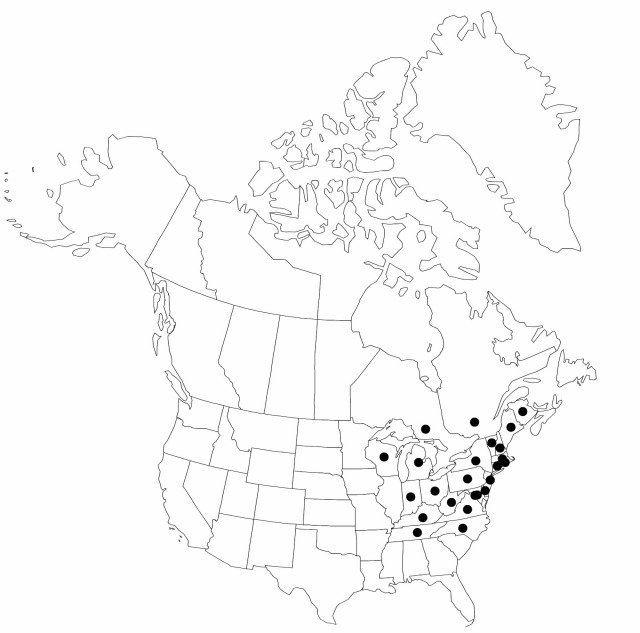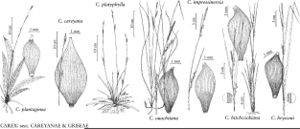Carex platyphylla
Amer. J. Sci. Arts, ser. 2, 4: 23. 1847.
Plants densely cespitose. Culms lateral, ascending, lax, or decumbent, very slender, 14–38 cm × 0.2–0.5 mm. Leaves: basal sheaths white or light-brown; sheaths green, lighter to white at base, 1–22 mm; blades erect, ascending, or lax, grayish blue-green, midrib strongly developed, 2 lateral-veins developed, 5–22 cm × (7–) 11–28 mm, older leaves shriveling or dead at tips. Inflorescences: spikes (2–) 3 (–4) per culm, scattered; peduncles of pistillate spikes exserted 0–2.2 cm; of staminate spikes 0.1–0.8 cm; bracts from middle and proximal portions of culms 1.4–5.2 cm × 2–6 mm. Pistillate spikes: the proximal basal, erect, 6–16 × 2.8–3.8 mm. Staminate spike 1, linear-clavate, 6–14 × 2–4 mm. Pistillate scales keeled, 3–6 × 1.8–2.2 mm, midribs green, margins hyaline or brown tinged outward, apex apicluate or aristate, awn to 2 mm. Staminate scales obovate, 2.7–5 × 1.8–2.2 mm, midribs green, margins hyaline and brownish to purple-tinged outward, apex obtuse to acute. Anthers 3.3–4 mm. Perigynia 2–9 per spike, overlapping, ascending, finely many-veined, obovoid, 3–3.2 × 1.8–2 mm; beak short curved. Achenes ovoid, 2.8–3 × 1.6–1.8 mm, slightly concave at maturity, tightly fitting in perigynia. Style ascending through entire orifice. 2n = 68, 70, n = 32 + (3), 33 + (3), 33 + (4).
Phenology: Fruiting spring.
Habitat: Rich, moist deciduous forests, on rocky or gravelly slopes, soils above limestone, shale, or calcareous metamorphic rocks, often on clay soils
Elevation: 100–1100 m
Distribution

N.B., Ont., Que., Conn., Del., D.C., Ind., Ky., Maine, Md., Mass., Mich., N.H., N.J., N.Y., N.C., Ohio, Pa., R.I., Tenn., Vt., Va., W.Va., Wis.
Discussion
Selected References
None.
Lower Taxa
"shortened" is not a number."wide" is not a number.
